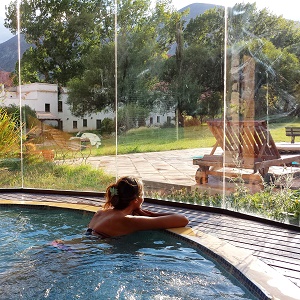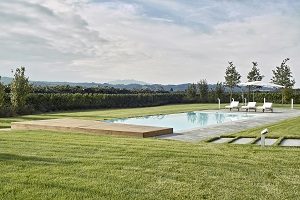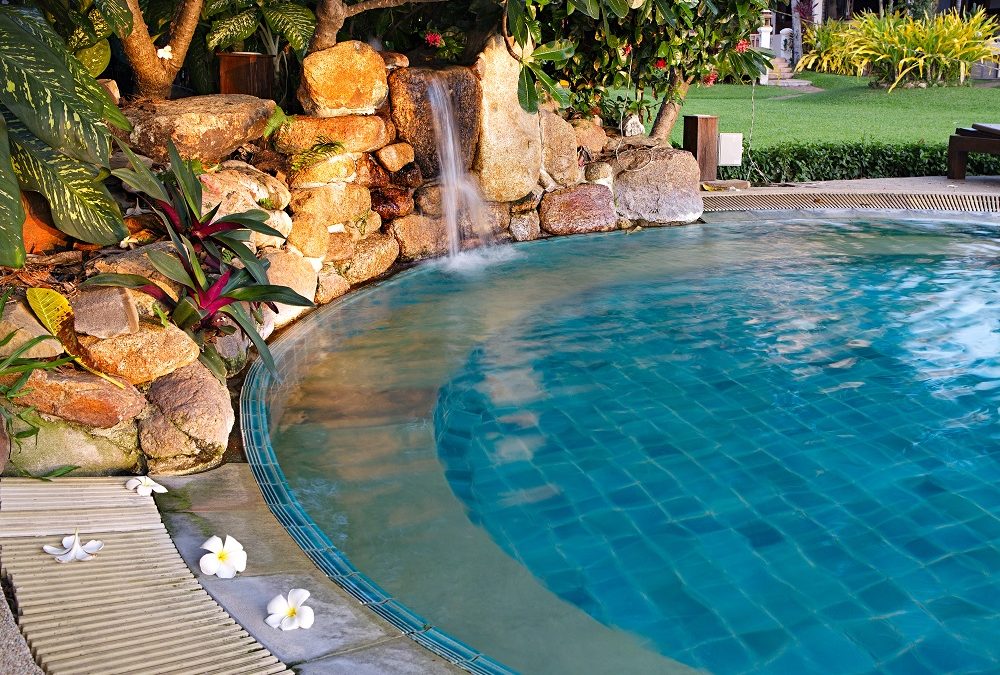An eco-friendly swimming pool is an oxymoron for many. It shouldn’t come as a surprise.
After all, swimming pools aren’t exactly what anyone would consider as sustainable or eco-friendly.
It’s estimated that a 15×30-foot backyard pool requires 38,000 gallons of water per year. That’s more than the average amount of water consumed by all the people living in any one state in the US!
One top of that, swimming pools in the US use a whopping 10 billion kilowatt-hours of energy each year. That’s responsible for over 7 million tons of carbon dioxide emissions that make its way into the atmosphere and absorbed by more than 5 million acres of US forests every year. This doesn’t yet include all the other greenhouse gasses that get thrown into the atmosphere as a by-product of producing the energy needed to run all the swimming pools or when pool water evaporates.
By now, you might start feeling guilty and want to just kick yourself for deciding to build a pool in your backyard. But take heart! The good news is that with a few tweaks here and there, you can actually have an eco-friendly pool right in your backyard.
Tips for an Eco-Friendly Pool
Make covering your pool a habit
 Did you know that your swimming pool can lose anywhere between 4 and 6 feet of water each year just because of a natural process called evaporation? Keeping your pool uncovered also causes heat loss from your pool water. Not to mention all those pool chemicals added in your pool water to keep it safe and clean, many of which contain components that have been found to be hurtful to our ozone layer.
Did you know that your swimming pool can lose anywhere between 4 and 6 feet of water each year just because of a natural process called evaporation? Keeping your pool uncovered also causes heat loss from your pool water. Not to mention all those pool chemicals added in your pool water to keep it safe and clean, many of which contain components that have been found to be hurtful to our ozone layer.
Getting into the habit of covering your pool with a pool cover whenever you’re not using it can easily cut back the amount of pool water and heat loss up to 97%. At the same time, a pool cover helps keep out debris like dirt and fallen leaves from your pool water, reducing the number of times you need to clean it, and lowering the pool chemicals you use up to 60%.
There are lots of different kinds of pool covers you can choose from. But, if you want to have an eco-friendly pool, go for a solar pool over. Aside from keeping out debris and helping lower your pool water’s evaporation rate, it also helps heat up your water, so you don’t have to keep on running your pool heater just to warm your pool water up a few degrees.
Switch to cartridge pool filters
Lots of pool owners think that using sand or DE (short for diatomaceous earth) pool filter is more eco-friendly because they use natural materials to filter out algae, organic material, and other debris from your pool water.
The truth is that sand and DE pool filters do more harm than good for the environment. Each time you backwash either your sand or DE pool filter, you use as much as 900 liters or 238 gallons of water. Considering that you need to backwash your pool filter every couple of weeks, this easily adds up to almost 4,000 gallons of water wasted just on backwashing each year.
Cartridge filters are more tedious to clean because you need to take out the cartridge itself to clean it. But the good thing about them is that they don’t need to be back washed. You can just hose down the cartridge to get rid of the trapped debris, or if you’re really eco-conscious, you can gently scrub off the trapped debris with a brush and a pail of water.
Invest in a variable speed pool pump
Variable speed pool pumps are, admittedly, much more expensive than standard pool pumps, averaging between $800 and $1,000. But they are sure worth the investment if you want to have an eco-friendly pool in your home.
As its name suggests, variable speed pool pumps can run at different speeds. That means that you can run it at slower speeds just enough to keep the water circulating and moving to prevent algae growth.
Install a pool pump controller
It’s very easy to lose track of when to turn your pool pump on and off. Unfortunately, these lapses often result in leaving a significant impact on the environment, and your wallet.
That said, install a pool pump controller that will allow you to program exactly when your pool pump turns on, at what speed, and when to turn off. This will not only help you save a lot on your electricity bill, but it will also help extend the life of your pool pump and filter since it’s not overworked.
Automate your pool water chemistry check
This next eco-friendly pool tip lives up to the saying, “prevention is better than cure.” By installing an automatic regulation device, such as PoolWatch, you don’t run the risk of putting in too much or too little chemicals in your pool’s water. At the same time, these regulation devices keep an eye on your pool water chemistry, adding just the right amount chemicals to keep your pool water’s chemistry at the right levels. That way, you lessen the chances of having to deal with common pool problems that require a lot more pool chemicals and water to fix as well as energy used by your pool pump and filter.
Switch to an eco-friendly pool cleaner
Most—if not, all—pool cleaning products are made from chlorine, simply because it’s the most effective. But it comes at a price. Chlorine is very dangerous to handle. It’s also very harsh on your hair, skin, and eye. Worst, chlorine is actually classified as a pesticide and is one of many greenhouse gasses that causes lots of damage in the earth’s atmosphere.
Fortunately, there are now alternative pool cleaners and sanitizers that you can use to keep your swimming pool clean and safe for swimming:
Ozone generator
Ozone generators work in the same way as saltwater pool systems. Instead of converting salt to chlorine, ozone generators suck air into a chamber filled with electrodes which break down oxygen molecules and converts them into ozone. The converted ozone is then sent into the pool water to kill bacteria, and other organic materials to sanitize your pool’s water. Ozone then reverts back into oxygen molecules, which is very safe.
Copper and silver ionizers
As its name suggests, this alternative pool sanitizing system emits electrically charged silver and copper ions into the water. The silver ions kill out the bacteria and virus while copper ions kill off algae and other organic matter. And because these ions don’t break down as easily as ozone, they’re able to keep your pool’s water safer for longer periods of time.
Ultraviolet (UV) sanitation system
This type of pool sanitation system uses light-based systems that emit rays with concentrated electromagnetic energy that targets the DNA or RNA of algae, bacteria, virus, cysts, protozoa, and other types of microorganisms. The intense UV rays also destroy organic matter and prevent the formation of harmful chlorine by-products.
The downside of using UV sanitation systems is that it’s not able to deal with getting rid of non-organic contaminants in your pool’s water, which is why you’ll still need to add some chlorine to your pool’s water.
 Go for a natural pool
Go for a natural pool
If you’re just planning to build a pool in your backyard or thinking about renovating your swimming pool, you might want to consider going for a natural pool rather than a conventional pool design.
Natural pools are perhaps the closest you can get to really having an eco-friendly pool in your backyard because unlike conventional swimming pools that require different pool chemicals and products to keep the water clean and safe for swimming, natural pools uses different types of water plants, stones, and even some types of freshwater fish to filter out all the impurities in the water to keep it clean and pristine. It does take some getting used to, but as soon as you get the hang of managing this, it’s practically maintenance-free.
Change your pool lights
LED lights may be more expensive than halogen or incandescent lights, but hey are way brighter than incandescent and halogen lights, and they don’t consume that much energy. They also last significantly longer than other kinds of pool lights. The best part is that you can change the color of your LED pool lights at the flick of a switch, perfect if you’re planning to host either a romantic dinner with your significant other or set the mood for a fun evening pool party with friends.
Use larger pipes
If you’re right in the middle of having your pool built or renovated, make it a point to ask your pool contractor to use pipes with a wider diameter and pipe elbows that bend at 45-degree angles for your pool’s plumbing system. This will help your pool water flow through the plumbing more easily so that you can set your pool pump at a lower speed, and reduce the amount of energy it consumes in the process.
Install a pre-filtration device
Another way to make your pool more eco-friendly is by installing a pre-filtration device, especially if you’re using sand or DE pool filter.
Just like what its name suggests, pre-filtration devices help filter out larger-sized impurities and contaminants from your pool’s water before it reaches your sand or DE filter. As a result, you don’t have to backwash your sand or DE pool filter that often. Pool owners that have installed a pre-filtration device have been able to cut the amount of water they use to backwash their pool filters as much as 50%.
Use rainwater to refill your pool
Instead of tapping into your main water line to refill your pool water so that it’s back to the right levels, use a rainwater diverter that you can hook up to a downpipe and divert the water into your pool. Be sure to choose one that’s got a filter so that fallen leaves and other debris don’t make their way into your pool. Also, make sure that you check your pool water chemistry to make sure that it’s at the right levels.
If you got some extra space in your backyard, it would also be a good idea to install a tank to collect rainwater so that you don’t have to wait for another rainy day to refill your pool.
Opt for a solar pool heater
In most cases, a solar blanket or solar pool cover will be more than enough to heat up the water of your pool so that it’s not too cold when you dive into it. But if you really need to install a pool heater, go for the solar type. They may be more expensive to install, but since they don’t consume any electricity or fuel other than the power of the sun, it basically pays for itself. Not to mention that installing a solar pool heating system can be written off when you file your taxes.
Check your swimming pool for leaks
This may seem a no-brainer, but you won’t believe how much this can really help make your swimming pool more eco-friendly. Even the smallest leak in your backyard pool can cause you to lose an inch of pool water. This quickly adds up to losing as much as 102,000 gallons of water every year.
A quick and easy way to check if your pool has got any leaks is by marking your pool’s water line with a grease pencil and check it after 24 hours. If your pool water level drops at least an inch, it’s a sure sign that your pool’s leaking. Check your pool’s plumbing system to find the leak and get this fixed immediately.
Get an automatic pool vacuum cleaner
Now, you may be wondering how an automatic pool vacuum cleaner can be a more eco-friendly choice to a manual pool vacuum?
Yes, it’s true that automatic pool vacuums need electricity to run. But, a robot pool cleaner is far more efficient in cleaning out the sides and bottom of your pool than you can do using a manual pool vacuum. Not only would this mean that you don’t have to keep on adding sanitizers and other chemicals in your pool to keep your water clean and safe for swimming.
Keeping the sides and bottom of your pool also lessens the amount of work your pool filter needs to do, which means that it doesn’t get dirty too quickly, so you don’t need to backwash it as often.
Build a windbreak
Adding trees and shrubs along the perimeter of your pool not only give you some shade and privacy while swimming. They also help slow down your pool water’s evaporation rate. They also can help prevent you from your pool’s water cooling down very quickly during windy days. More important, they absorb some of the carbon dioxide from the chemicals you’ve added into your pool.
Just make sure to choose trees and shrubs that don’t shed their leaves and their barks. Also, make it a point to plant them some distance away from your pool. Otherwise, the leaves and branches would fall into your pool’s water during really windy days.
So there you have the different ways on how to maintain an eco-friendly pool. It’s true that many of the eco-friendly tips listed here would mean changing a lot of your pool equipment into those that are more expensive. But if you choose to make that investment and go with these alternative pool maintenance tips, you can be assured that you’ve done your part in decreasing you and your pool’s carbon footprint, lessen the amount of greenhouse gases that get absorb into the atmosphere, conserve water, and get lots of savings on electricity and tax rebates.

